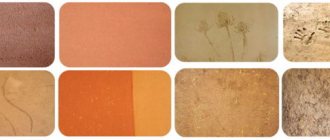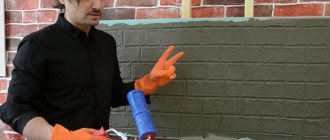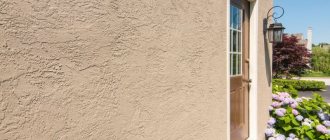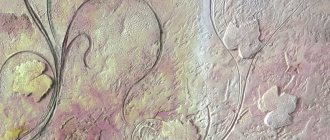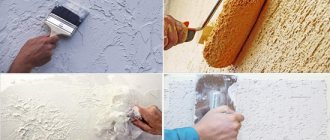Textured plaster is a material for finishing work indoors and outdoors, which allows you to make walls aesthetically pleasing and the interior of rooms spectacular. A wide variety of plasters gives you room to choose the type that suits you 100%.
The product is valued for its variety of effects, high user characteristics, quality, and durability. Not only a professional can apply the material to the wall. Textured plaster for walls creates a volume effect - it is a stylish alternative to wallpaper and painting.
Textured plaster for walls, applied in circles
Advantages of textured plaster
The possibility of using textured plaster allows you to experiment with the decor of the room. It is suitable for any type of premises, regardless of their purpose. The obvious advantages of the coating include:
- Easy application method. To decorate a plane, you do not need to have specialized skills, so anyone, even a beginner, can cope with this task.
- The plasticity of the material allows it to be evenly distributed over the surface, applying layer after layer, and creating fancy and original designs.
- Properties such as strength and durability of use speak for themselves. Textured plaster is slightly susceptible to the influence of harmful and destructive factors, be it temperature, moisture or detergents. It retains its original appearance for a long time, which is easily maintained with the simplest care products.
- Aesthetic appearance . Special additive materials in the composition play a decisive role in the formation of the unusual structure. Small stone chips and other various inclusions allow you to replicate the structure of a marble or sand coating. Recently, plaster has become increasingly popular, allowing you to recreate the structure of an orange peel or a surface that has been exposed to insects. The color palette is also quite extensive and will satisfy any customer request. In this regard, it is quite difficult to determine the final choice, so manufacturers have created catalogs with various structure options.
- Easy to care for. Walls decorated with textured plaster can be easily cleaned from various contaminants using detergents. They do not affect the appearance of the coating and do not worsen its condition.
- Affordable cost of material . If we compare with other types of finishing plaster, the cost of textured plaster is quite attractive. Installation costs are also low, since no complex or expensive devices or facilities are required.
What is the material
Conventional plaster is intended for rough work, leveling the base and creating a base layer for further finishing. This is a mixture that has a heterogeneous viscous consistency. After application to the wall, the mass is well leveled and formed due to the plasticity of the composition. Textured plaster is the same mixture, only intended for decorative finishing.
This is possible thanks to the fillers in the composition, which allow the formation of patterns and other visual effects on the surface. The fillers are stone chips, sand, gypsum, wood fibers, crushed brick, etc. The texture of different types of products is individual. Before you start using textured plaster, you should consider its features, positive and negative characteristics.
Types of material
Since the market range of textured plaster is quite wide, it began to be classified according to several basic parameters. The texture of the material can be fine, small, medium and large. Depending on the type, the thickness of the applied coating and the size of the pattern vary.
The main criterion by which it is customary to divide plaster into types is the binder. This filler affects the drying speed of the material and its quality characteristics. The following types are distinguished:
- Silicate , created on the basis of special liquid glass. It is distinguished by its resistance to steam and moisture. It can be applied to any surface, even concrete, so it is considered a universal type. The finished silicate plaster surface is durable and resistant to mechanical damage.
- Mineral plaster belongs to a more affordable price category, but this does not at all affect its quality characteristics and service life. In this type, cement acts as a binder. In addition to it, the mixture contains several other dry additional elements that give the structure texture and elasticity. Typically these are various minerals, quartz and sand. You can buy it in dry form, then dilute it with water and mix thoroughly.
- Acrylic plaster is created on the basis of a special acrylic resin, which is the main component of the composition. You can purchase it in a form ready for finishing work. Before application, the material must be mixed well with available means. If part of the plaster has not been used, it can be stored for a long time, but the manufacturer recommends using all of it. The pricing policy of this type differs depending on the manufacturer’s brand, but in terms of their characteristics they are on the same level.
- Plaster, the main components of which are polymer resins, is called silicone . It is well resistant to prolonged exposure to moisture and temperature changes, so it is excellent for decorating bathrooms and building facades. The approximate service life is 15 years. Despite its high quality characteristics, silicone plaster belongs to an affordable price category.
Preparing the walls
Any plastering work is carried out on a prepared surface.
- Remove peeling paint and clean surfaces from dust.
- Large cracks are covered with putty or filled with foam using a construction gun.
- The base is washed and left to dry.
Rules and stages of application
At the very beginning, you need to look at the options for ready-made coverage and make a choice. Then comes the purchase of the plaster itself and all the necessary tools.
The next stage is preparing the working surface . It is necessary to remove all fasteners (if any) and additional elements from it. Surface unevenness, cracks and potholes are carefully sealed using putty. Then you should remove dust from the prepared surface and apply 2 layers of primer. When choosing a composition, it is better to give preference to a deeply penetrating one, which will ensure stronger contact between the plaster and the surface. Do not forget that the floor covering, decorative items and furniture should be covered with a special protective film.
Applying textured plaster with your own hands is a simple process, the main thing is to approach the matter carefully. Basic work begins with preparing the solution, if the choice fell on a dry mixture. To begin with, it is best to carefully read the manufacturer's instructions, which are printed on the packaging itself. Following it will help you get a high-quality coating with good characteristics.
Next, using a wide spatula, the composition is transferred to the prepared surface. Maintaining uniform application is not so important; the main thing is to apply the mixture over the entire wall area.
Then you need to smooth the plaster using a special smoother. To create a high-quality and beautiful texture, the layer of material on the wall should be approximately 1.5 millimeters. You need to work especially carefully with the corners of the surface so as not to miss anything and preserve the structure. Apply and spread the plaster over the wall using narrow spatulas.
At the next stage, the texture is created. There are many tools and different techniques for this, but the simplest and most popular are special rollers, stencil stamps and trowels.
Creating texture using a roller is the easiest option . You can use a tool with long or short bristles, or you can take a closer look at curly rollers. They allow you to create a pattern on the surface in one go. In this case, the entire surface is completely in the hands of the master.
A trowel and a notched spatula allow you to create a texture that will imitate a stone surface. It also allows you to create plaster that will copy fabric or leather materials. For such effects, you need to go through the instruments in a certain or chaotic order. They can also be used to create complex designs and patterns, but this will take more time.
Stencil stamps look like rubber or polymer fabric with a clear relief pattern. They are applied to the surface, after which an imprint of the pattern remains on it. The complexity of the process lies in the fact that they constantly need to be washed, and during application it is necessary to correctly distribute the pressing force. If you press unevenly, the pattern will be deeper in one part and unclear in another.
After the texture has been created, the surface must be given time to dry. This stage depends on the type of plaster, because some dry faster, some take longer. When the surface has dried, it is covered with a layer of primer and painted. The most common way is to apply two coats of paint, with the second coat being slightly lighter than the first. If you use plaster to which dye has already been added, the painting process can be skipped. At the last stage, the finished surface is treated with varnish or wax.
Work algorithm
Stages of decorating walls with textured mixtures:
- It is better to purchase the required amount of dry mixture corresponding to the footage of the walls (the consumption of textured plaster is indicated in the instructions).
- Preparation of tools, including a round for kneading and application, a set of spatulas of different widths.
- Cleaning the surface of the walls, removing old paint, wallpaper, flaking putty, as well as sealing small cracks.
- Applying a starting base, if wall leveling is required, is often enough to eliminate minor defects and irregularities.
- Cover the surface with a primer and leave until completely dry (time specified in the instructions for use).
- The main stage is the application of plaster with an even distribution over the surface with the formation of a relief.
- After the layer of decorative plaster has dried, you can “preserve” the walls by painting or covering them with moisture-resistant varnish.
The textured plaster solution is applied with a wide spatula and stretched over the surface with confident gestures. It is advisable to level it with a grater, work confidently, but without effort, so as not to “pull” the layer.
The rustic texture is formed with special devices, but you can experiment with crumpled foil, convex elements, and a roller attachment with faux fur.
For more details, watch the video of applying decorative bark beetle plaster with your own hands.
Special formulations
There are many types of ready-made textures, so in some cases it is worth using special mixtures. Let’s say that to imitate a wooden surface that has been treated by a bark beetle, there is a mixture of the same name. This will reduce the time and effort spent on creating the texture. The bark beetle mixture may contain soft granules that will burst during application. Due to this, areas of the surface will have slightly different shades. The grooves can be made in different directions to add originality.
Decorating a room using textured plaster does not require any specific skills. It is important to choose the right material, tools and correctly distribute the order of work. Then the end result will be pleasing to the eye and give the interior originality.
Finishing features?
Textured plaster for walls with a city effect in the interior
- The main nuance is the composition of the product, which determines the subtleties of working with it and the design that results. The composition may include pieces of minerals - for example, granite.
- The word “textured” indicates that the result of the coating will be voluminous - this looks exclusive in modern and classic interiors.
- It is recommended to apply it to a flat wall, but this is not important - the texture hides some imperfections.
- The main task is to decorate the room; the desired design is created in different ways after the product is applied to the wall. A thin layer is enough to get the desired pattern, texture, pattern.
- Properties: plasticity, strength, viscosity, no shrinkage after drying, ease of application, resistance to moisture and temperature changes.

